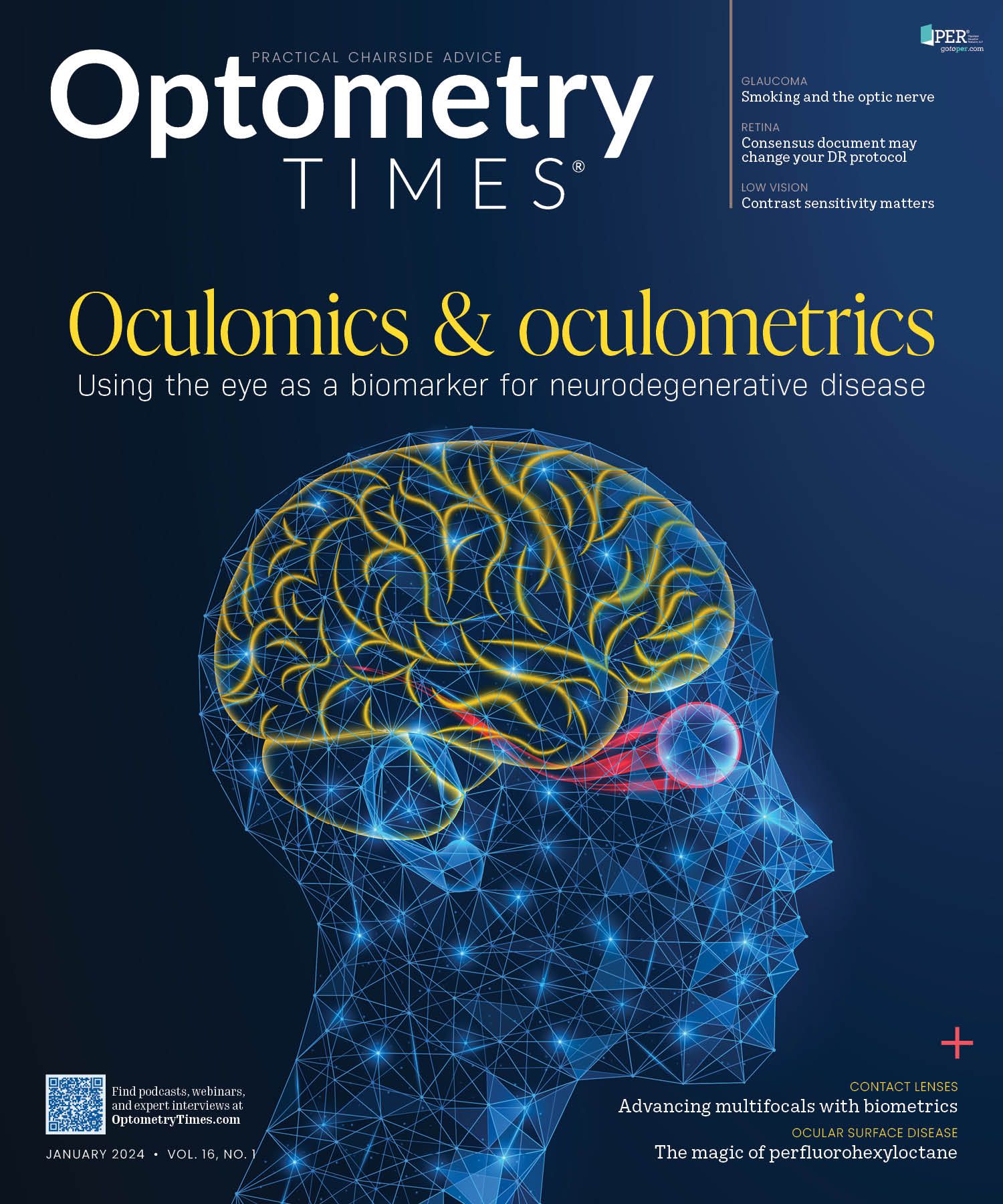Why is contrast sensitivity important?
When a patient has low contrast sensitivity, it means they have difficulty perceiving and distinguishing objects or patterns with subtle differences in contrast. This can have several implications for their vision and daily life, since our world is not merely black and white.
Image Credit: AdobeStock/Prostock-studio

The diagnosis and management of contrast sensitivity is a large part of a low vision examination. It is a crucial aspect that is often not discussed or explored during a regular eye exam, but it greatly impacts a patient’s perception of the world.
The concept of contrast sensitivity pertains to patients’ visual perception, specifically their capacity to differentiate between items or patterns that exhibit varying levels of contrast. Contrast, in this context, refers to the disparity in luminance or color between an object and its surrounding background. A contrast sensitivity assessment evaluates an individual's capacity to discern nuanced distinctions in shade, brightness, or variations in color.
The assessment of contrast sensitivity is a crucial component of a low vision examination as it impacts the capacity to see and differentiate objects under different illumination conditions, particularly in situations with low levels of contrast. The challenge encompasses more than merely identifying an object; it also involves the discernment of intricate details and subtle distinctions within an image or object.
The representation of contrast sensitivity is commonly depicted by a graph known as the contrast sensitivity function (CSF). The graph illustrates the response of an individual's visual system to varying levels of contrast across different spatial frequencies, which refers to the number of pattern cycles per unit of visual angle. CSF generally exhibits a peak at a specific spatial frequency, denoting the point of highest sensitivity to contrast at that frequency. Individuals with decreased contrast sensitivity may experience difficulties recognizing small details, particularly in dim lighting settings, due to visual impairments or certain eye disorders.
How is contrast sensitivity measured?
The Pelli-Robson Contrast Sensitivity Chart is a standardized tool used in the field of vision science to assess an individual's ability to perceive and discriminate contrast. It is likely the most used assessment in low vision clinics. The chart is composed of successive rows of letters that exhibit a gradual reduction in contrast. Participants are instructed to visually perceive the letters, and their ability to discern contrast is assessed by identifying the row with the lowest contrast that they can reliably read. The findings are commonly presented in logarithmic units.
A similar test to the Pelli-Robson test is the Mars contrast sensitivity test, which also involves letters organized with successively reduced contrast sensitivity. Both tests have relatively equal reliability and accuracy and are found in most low vision clinical settings.
Computer-based contrast sensitivity testing is becoming more popular as the range of software tools and mobile applications become more accurate and reliable. The most popular example is the Freiburg Visual Acuity and Contrast Test (FrACT), which is designed to evaluate an individual's visual acuity and contrast sensitivity using various optotypes, such as letters, pictures, and the Landolt C. An example of a mobile application is the CSTest available on iOS and Android app stores. Mobile applications frequently involve the presentation of stimuli on a computer or phone screen with the patient participating by clicking presented stimuli.
Electrophysiological testing refers to a diagnostic procedure that involves the measurement and analysis of electrical activity in the body. Examples of this method include electroretinography and visual evoked potentials. These tests offer insights into the functionality of the retina and visual pathways in relation to contrast sensitivity.
What causes a decrease in contrast sensitivity?
There are various ocular illnesses and diseases that have the potential to impact or diminish an individual's contrast sensitivity. These conditions can result in increased difficulty when performing a range of daily tasks. These are also conditions that most eye care providers diagnose on a regular basis.
Cataracts refer to the opacification of the lens, resulting in diminished light transmission and the increased dispersion of incoming light. This phenomenon may result in a reduction in contrast sensitivity and visual blurring.
Glaucoma refers to a collection of ocular disorders that are distinguished by heightened intraocular pressure, resulting in potential harm to the optic nerve. As the condition advances, it has the potential to impact contrast sensitivity, which can happen in conjunction with peripheral vision loss.
Age-related macular degeneration (AMD) is a pathological disorder that impacts the macula, which is the central region of the retina responsible for central vision. AMD is a frequent cause of a significant decrease in contrast sensitivity due to its detrimental effect on the macula.
Diabetic retinopathy is a condition that arises due to alterations in the retinal blood vessels as a consequence of diabetes. Some patients with diabetic retinopathy experience swelling or fluid buildup in the retina, which can cause a temporary or permanent reduction of contrast sensitivity.
Retinitis pigmentosa is a hereditary condition characterized by the progressive deterioration of the photoreceptor cells of the retina. As the disease progresses, it is common to see a reduction in contrast sensitivity and loss of peripheral vision.
Optic neuritis refers to the inflammatory process affecting the optic nerve, frequently observed in conjunction with several pathologies, such as multiple sclerosis. The condition has the potential to induce a decrease in contrast sensitivity, as well as other visual disruptions.
Albinism is a hereditary disorder that is distinguished by the deficiency or diminished synthesis of melanin, resulting in alterations in the pigmentation of the eyes, skin, and hair. Individuals diagnosed with albinism may experience a decrease in contrast sensitivity as a result of atypical development of the retina and optic nerve.
Keratoconus is a pathological condition affecting the cornea, characterized by a gradual thinning of the corneal tissue and subsequent protrusion. The occurrence of increased irregular astigmatism has the potential to impact contrast sensitivity.
Neurological conditions including traumatic brain injury can impact the brain's ability to discern differences in contrast. Children with cerebral vision impairment also have been known to experience dampened contrast sensitivity.
It is worth noting that the natural process of aging can also result in a minor decline in contrast sensitivity. This can be attributed to expected age-related changes to the eye such as pupil size, changes to the lens, and more.
What happens if a patient has decreased contrast sensitivity?
When a patient has low contrast sensitivity, it means they have difficulty perceiving and distinguishing objects or patterns with subtle differences in contrast. This can have several implications for their vision and daily life since our world is not merely black and white.
- Reduced depth perception: Contrast is a very important part of being able to see depth. Low contrast sensitivity can make it hard for a person to judge distances correctly. This can make it difficult to do things that require depth awareness, like going up and down stairs or figuring out how close something is to your car when driving.
- Compromised safety: Decreased contrast sensitivity can make it more difficult to notice changes along the road when driving or obstacles on the ground when walking. In the home, a patient may miss a sharp tool on the counter in the kitchen or slip on spilled liquids on the floor.
- Visual fatigue: Spending a long time straining to see images with low contrast can cause visual fatigue and pain. This fatigue can be discouraging for tasks that are typically done for a prolonged period of time, such as reading, knitting, writing, and more.
- Loss of detail: It can be hard to see small details in items, text, or images. This can make it hard to read small print, recognize people, or figure out complicated patterns.
- Decreased flexibility: People with low contrast sensitivity may find it harder to do things in low-contrast environments, such as when it's foggy or dark, or there's not much light. This may restrict what time of day a patient can leave their house.
In summary, the impact of a loss of contrast sensitivity on a patient’s day-to-day life is profound, but it is also very common, especially with increased age. It is imperative for eye care providers to recognize any deficits and refer the patient to a low vision specialist for evaluation when diagnosed with any of the diseases noted above or in the presence of unidentifiable visual complaints.

Newsletter
Want more insights like this? Subscribe to Optometry Times and get clinical pearls and practice tips delivered straight to your inbox.